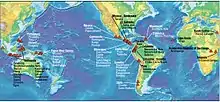Volcano Disaster Assistance Program
The Volcano Disaster Assistance Program (VDAP) was developed by the U.S. Geological Survey and the United States Agency for International Development's Office of U.S. Foreign Disaster Assistance after the eruption of Nevado del Ruiz (Colombia) in 1985.[1] The volcanic eruption melted a glacier triggering a lahar that killed 25,000 people. It was determined that increased monitoring and enhanced communications between scientists and civil authorities would make it easier to evacuate local populations and save lives. Today the program responds to volcanic crises around the world. The aim of the program is to assist in saving lives and property, to reduce economic losses, and to prevent a natural hazard becoming a natural disaster. VDAP staff members are based at the USGS Cascades Volcano Observatory, in Vancouver, Washington. VDAP channels its energy into four main activities: response to natural disaster, capacity building, training, and volcanological research.[2]
Response
VDAP responds primarily to ‘non-domestic’ eruptions outside the United States. Since 1986, the team has responded to over 70 major events around the world. Scores of other remote responses involve consultations with the relevant local observatories. A subset of foreign responses are listed in the following table and on the map.
| Location | Year | Disaster Responses |
|---|---|---|
| Mount Pinatubo, Philippines | 1991 | Less than 5 years after its creation, VDAP was called to assist an eruption of Pinatubo in April 1991. The volcano is monitored by the Volcano Disaster Assistance Program's crisis-response team. Around 75,000 people and US$250 million to $375 million worth of equipment were evacuated before the major eruption. |
| Merapi, Indonesia | 2006 | Eruptions at Merapi affect more than a million people. A small team travelled out in 2006 to improve seismic monitoring and provide more remote sensing data.[3] |
| Nevado del Huila, Colombia | 2007-2008 | VDAP were involved in successfully forecasting an eruption[4] and the evacuation of over 4,000 people.[5] |
| Chaitén, Chile | 2008 | A small team helped to install real-time seismic monitoring to help scientists more closely watch the volcano and understand its activity.[6] |
| Merapi, Indonesia | 2010 | VDAP worked with the Indonesian Center for Volcanology and Geologic Hazard Mitigation (CVGHM) to use satellite data to analyze activity at the volcano, helping to save thousands of lives with preemptive evacuations.[7] |
Preparation and Monitoring
Capacity building involves the development of education and monitoring in hazardous areas. The small group of scientists involved in the program work on eruption forecasting and assessing the hazards in volcanically active areas. This is usually carried out when there is not a crisis to work on. This kind of work has been carried out in Central and South America since 1998, Papua New Guinea (1998-2000) and Indonesia since 2004.
Training
VDAP holds workshops and training courses around the world. Many of these involve remote sensing and Geographic information system (GIS) modelling. VDAP assists as part of CSAV (Center for the Study of Active Volcanism) [8] a six-week international course in Hawaii and Vancouver, WA. The students include geologists, geochemists and geophysicists, who receive training in the science behind volcano monitoring.[9]
Research
VDAP supports projects which improve the forecasting of eruptions or better characterize the effects of previous eruptions. Examples of this include research at Pinatubo [10] and Chaitén Volcano, Chile.[11]
References
- U.S. Geological Survey Fact Sheet 2017–3071, 6 p., https://doi.org/10.3133/fs20173071.
- Tilling, R.I. (2010), Volcanic hazards and their mitigation: Progress and problems,Reviews of geophysics, 27,2
- VDAP Responses at Merapi in Indonesia
- 1 INGEOMINAS and VDAP Responses at Nevado del Huila, Colombia
- Nevado del Huila volcano forces mass evacuations
- eruption in Chile sparks interest in National Volcano Early Warning System
- Revolutionizing Volcano Monitoring in Indonesia
- CSAV
- VDAP Training
- https://pubs.usgs.gov/pinatubo/contents.html
- http://www.andeangeology.cl/index.php/revista1/issue/view/344
